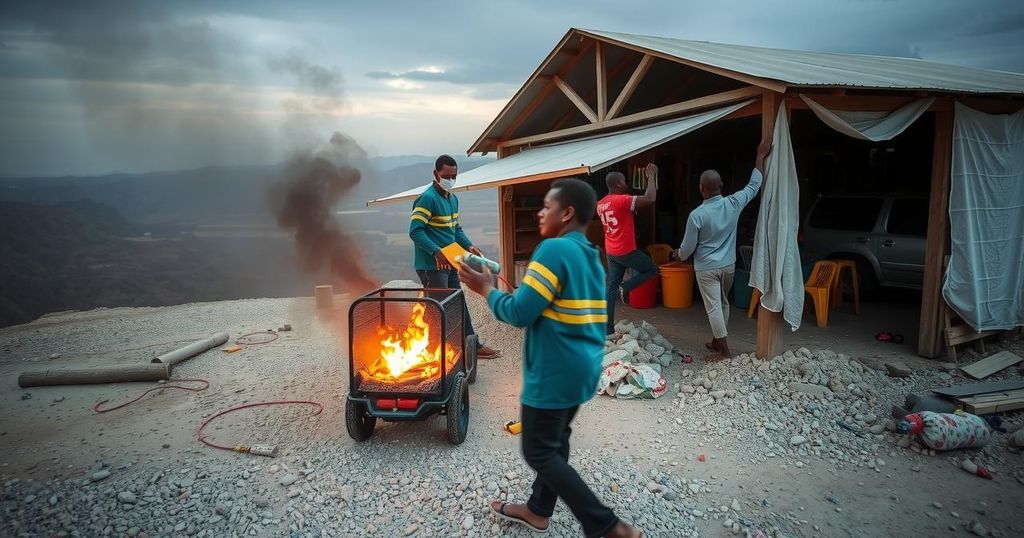Ethiopia Evacuates 80,000 Amid Increasing Earthquake Activity and Volcanic Concerns
Ethiopia is evacuating around 80,000 people due to recent earthquakes in the Afar, Oromia, and Amhara regions, with signs of potential volcanic activity. Notably, a 5.8 magnitude quake was recorded, prompting urgent government response including assessments and relocations to ensure public safety against recurring seismic threats.
Ethiopia is currently undertaking the evacuation of approximately 80,000 individuals due to a series of small earthquakes occurring within the Afar, Oromia, and Amhara regions of the country. The seismic activity includes at least ten reported earthquakes since last Friday, with signs indicating potential volcanic activity in the area. The United States Geological Survey documented a significant earthquake measuring 5.8 magnitude, located 56 kilometers southeast of Ambosa in the Oromia region early on Saturday morning. Atalay Ayele, the head of the Seismology Department at Addis Ababa University, stated that the epicenter was situated in Dofen Mountain, within the Awash Fentale district of the Afar region.
Following the initial earthquake, a subsequent tremor of magnitude 4.7 was recorded in close proximity. An official government statement indicated a concerning increase in the frequency and intensity of seismic events, particularly emphasized by the 5.8 magnitude quake and aftershocks felt as far as Addis Ababa. The quakes have caused damage to numerous homes in the Afar area, though there have been no confirmed casualties to date, and residents are being urged to evacuate to safer locations.
The federal government is maintaining vigilant oversight of these seismic activities and has mobilized emergency workers to assess damage and identify vulnerable populations among the evacuees. The Ethiopian Disaster Risk Management Commission reported that over 51,000 residents are at risk due to the frequent earthquakes of the past two months, with steps already taken to relocate approximately 13,000 individuals to safer zones. Local residents express their fears, describing the jarring experiences during earthquakes that have compelled many to sleep outdoors, reflecting a growing anxiety about their safety.
Meanwhile, experts have raised alarms regarding the structural integrity of buildings within Ethiopia, particularly in urban centers like Addis Ababa, where adherence to building codes has been critically insufficient. Esayas Gebreyohannes, an associate professor at Addis Ababa University, outlined the need for updating existing codes, highlighting that many buildings currently fail to meet required safety standards.
Given the recent uptick in seismic activities, government engineering officials have initiated plans to enhance the resilience of public structures against potential high-magnitude earthquakes. The Ethiopian Construction Authority is actively monitoring the situation and developing comprehensive reports aimed at addressing the emerging threats posed by these natural events.
The recent series of earthquakes in Ethiopia, particularly affecting the Afar, Oromia, and Amhara regions, has prompted concerns about both public safety and the integrity of infrastructure. Experts have indicated that the frequency and magnitude of these earthquakes could suggest an increased risk of volcanic eruptions, especially with the activity observed near Dofen Mountain. Historic concerns regarding building codes and construction practices further aggravate the situation, highlighting the urgent need for both immediate and long-term solutions to mitigate risks.
In summary, Ethiopia is facing a significant natural threat due to a series of earthquakes resulting in the evacuation of tens of thousands of residents. With ongoing volcanic activity signs and inadequate adherence to building safety standards, the government is working diligently to address these challenges through evacuations, assessments, and infrastructure improvements. The response to the evolving seismic threat emphasizes the need for heightened awareness and preparedness within the affected communities.
Original Source: www.voanews.com




Post Comment